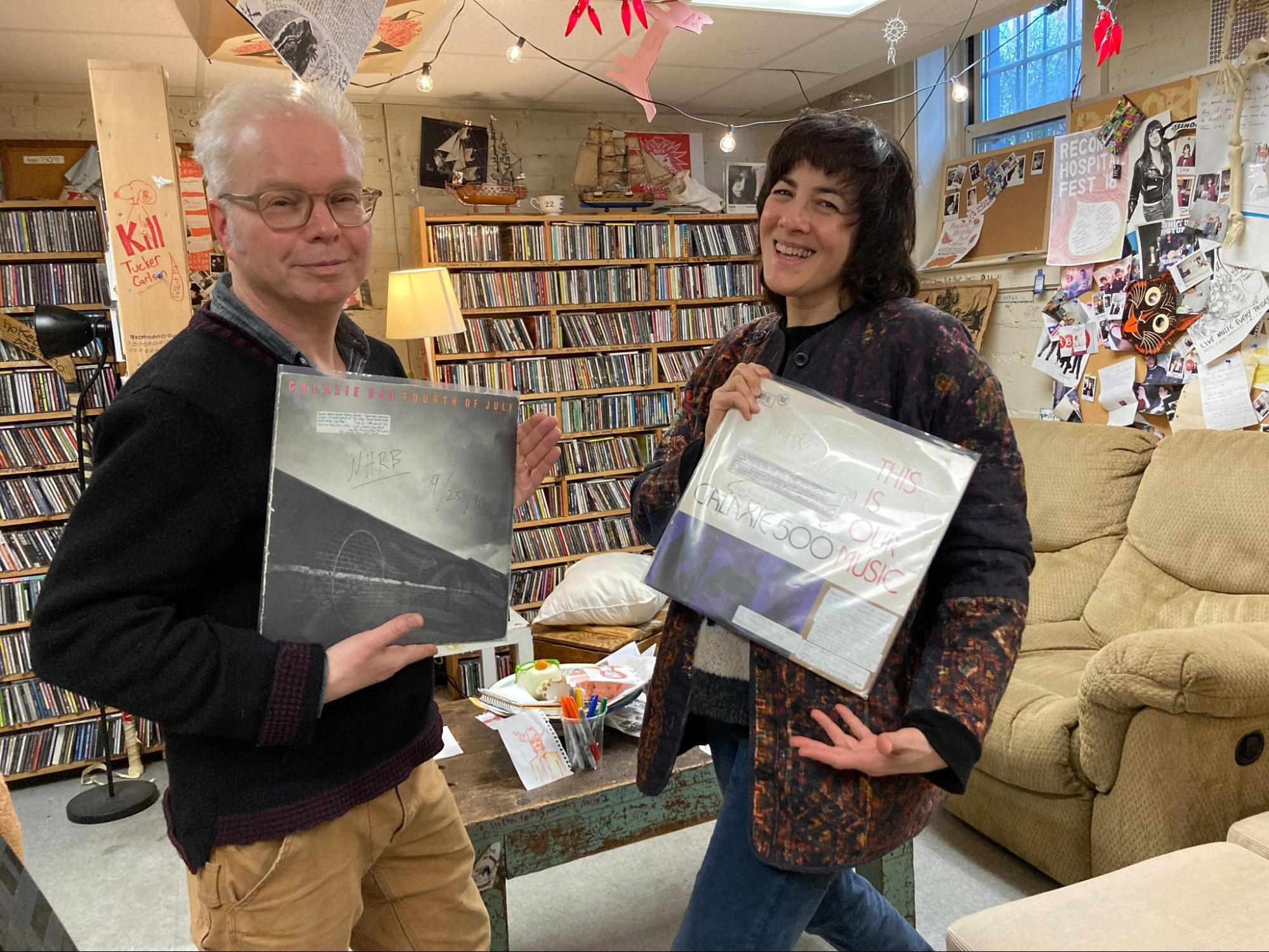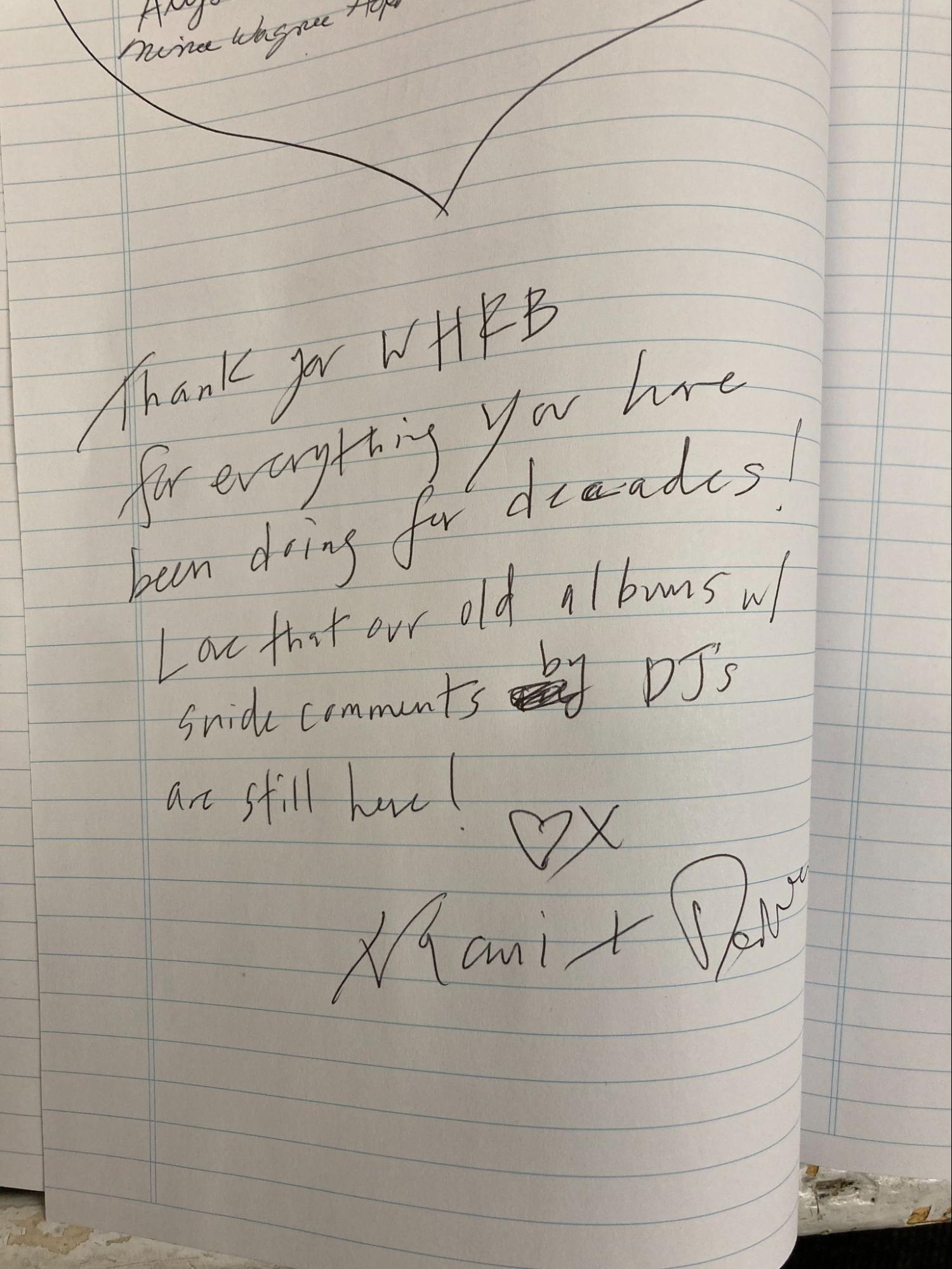Out of the Sleeves and Into the Studio with Damon Krukowski and Naomi Yang

// Damon and Naomi in the Record Hospital lounge. By Molly Egan
On every corner of this campus there are odes to the long list of Harvard’s alumni. From calcified plaques listing colonial ghosts to rows of portraits boasting white-toothed politicians and industry leaders, there's no escaping the weight of the many successful students who once put pen to paper here.
At WHRB, our commemorations of campus history are a bit more ... bohemian. Graffitied ceilings, marked-up record sleeves, and unprocessed audio tapes have collected through the years to create an archive of Harvard’s more underground scenes. For two alums, Damon Krukowski ’85 and Naomi Yang ’86, their faces are forever memorialized in WHRB’s rock section, where we hold pressings from their time in Galaxie 500. Together with WHRB ghost Dean Wareham ’85, the trio produced three albums and toured internationally from 1987 to 1991. Nowadays, Damon and Naomi continue to make music as a duo. The influence of their work on the dream pop sound is entirely tangible, and their influence on me meant I had to get them into the station for an interview.
Although Galaxie 500 wasn’t in its fullest form until after graduation, Damon played with Dean in their band Speedy and the Castanets during their undergraduate years. Damon remembers being “much reviled” on campus; the band’s biggest moment was a case of mistaken identity, when The Crimson ran a picture of Damon and Dean labeled as a different group.
“Nobody took us seriously besides our girlfriends — and maybe even our girlfriends didn't take us seriously. They humored us,” Damon says. Naomi is more sympathetic, interjecting: “I took you seriously. I did.” Although she was not yet part of the band, Naomi tells the story of arriving her freshman year to Wigglesworth Hall with Damon’s sparkling green drum kit in hand. “We unloaded them into my dorm room, and my roommates were horrified. Like, who is this new roommate who’s arrived with drums?”
After graduation, when Naomi picked up a “cute” bass with a “weird” sound from Cambridge Music Center in Porter Square, the band began to craft their pioneering sound. “There’s a moment when you realize you're actually making a sound you haven't heard anyone else do — before that we were just trying to sound like other bands,” says Damon.
It was never sitting alone and practicing that got them there. Instead, the social aspect of playing together was the driving beat beneath the band’s development. “We had a reverse snobbery about people who knew how to actually play their instruments. We really came out of punk rock,” says Damon. Experimenting with lyrics, melodies, and rhythms was how they spent their evenings. “It was great fun,” says Naomi, “To be irresponsible, and not be where I was supposed to be — at the Graduate School of Design, 24/7, all night long — but to be at the dive-y club playing with my band.”
The nights at these dive-y clubs were plentiful. “We looked back on one of Naomi’s old calendars from grad school, and saw we had two or three gigs a week! At different venues, each of those,” says Damon. “It was about bringing people into the bars. That’s where we hung out.”
“If you wanted to find out what was going on in the world, you had to go outside and do something, and be with other people,” says Naomi. “You heard about a band, maybe you heard their record on college radio. Then, how would you hear more? You had to listen to college radio and try to hear more. If you really wanted to know what they looked like or know what it felt like, you had to wait and see them when they came to town.”
With pride, I can report that Damon and Naomi remember WHRB as the sole proprietor of taste on this otherwise drab campus. If it wasn’t college radio, it was the countless record stores throughout the city. “A lot of our education came from In Your Ear,” says Naomi, a record store near BU that shut its doors in 2022. “Always behind the counter was some wise old guy that would either say that was a good record, or point you to something else.” “It wasn’t even shopping, it was more like exchanging information,” says Damon.
If you’re anything like me, you might be nostalgic for an era where a walk through Harvard Square would feel like the scene above, rather than a stroll through Big Bubble Tea’s best advertising efforts. But there’s no reason for pessimism, as Naomi explains. “The question is not to go backwards, but how, with the technology there is now, we can add to it to be more personal, more real, more justified.” It’s true that the internet provides us with new ways of connecting with our favorite artists, she adds — “I would follow Ian Curtis’ Instagram.”
I ask how the creative process has changed as the two have gotten older. In their duo, there is more of an emphasis on lyricism, rather than the overall sound. “When we go out live, the song has to communicate in some other way than just the sound of the band,” says Damon. “We started, thinking, ‘What’s a band? It’s a group that has a sound.’ But now, it’s more ‘What’s the song? How is the song portable in different circumstances?’”
 // A note from Naomi and Damon in WHRB’s guestbook. “Love that our old albums with snide comments by DJs are still here!” By Molly Egan
// A note from Naomi and Damon in WHRB’s guestbook. “Love that our old albums with snide comments by DJs are still here!” By Molly Egan
The two have never stopped experimenting with their sonic capabilities. Naomi began learning the synthesizer to score her recently released film Never Be a Punching Bag for Nobody. “It’s so mysterious, very amorphous. I start in one place and end up way somewhere else,” she says of the analog synth.
I was surprised to meet such cheerful people behind the Galaxie 500 albums I normally put on in my most antisocial states. I asked about an old interview where a younger Damon cited the “dark and the cold, the cemeteries” as his favorite parts of Boston. Now, the couple laughs at the angst of days past. After all, everyone deserves their time to be punk rock, including the WHRB DJs who marked the Galaxie 500 albums as undeserving of any airtime. Cool never recognizes cool until 35 years later, and by that point, we’re all On Fire anyways.
// Molly Egan ’26 is a staff writer for Record Hospital.